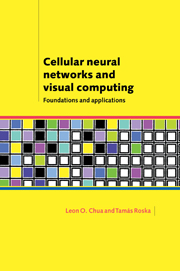Book contents
- Frontmatter
- Contents
- Acknowledgements
- 1 Introduction
- 2 Notation, definitions, and mathematical foundation
- 3 Characteristics and analysis of simple CNN templates
- 4 Simulation of the CNN dynamics
- 5 Binary CNN characterization via Boolean functions
- 6 Uncoupled CNNs: unified theory and applications
- 7 Introduction to the CNN Universal Machine
- 8 Back to basics: Nonlinear dynamics and complete stability
- 9 The CNN Universal Machine (CNN-UM)
- 10 Template design tools
- 11 CNNs for linear image processing
- 12 Coupled CNN with linear synaptic weights
- 13 Uncoupled standard CNNs with nonlinear synaptic weights
- 14 Standard CNNs with delayed synaptic weights and motion analysis
- 15 Visual microprocessors – analog and digital VLSI implementation of the CNN Universal Machine
- 16 CNN models in the visual pathway and the “Bionic Eye”
- Notes
- Bibliography
- Exercises
- Appendices
- Index
6 - Uncoupled CNNs: unified theory and applications
Published online by Cambridge University Press: 28 May 2010
- Frontmatter
- Contents
- Acknowledgements
- 1 Introduction
- 2 Notation, definitions, and mathematical foundation
- 3 Characteristics and analysis of simple CNN templates
- 4 Simulation of the CNN dynamics
- 5 Binary CNN characterization via Boolean functions
- 6 Uncoupled CNNs: unified theory and applications
- 7 Introduction to the CNN Universal Machine
- 8 Back to basics: Nonlinear dynamics and complete stability
- 9 The CNN Universal Machine (CNN-UM)
- 10 Template design tools
- 11 CNNs for linear image processing
- 12 Coupled CNN with linear synaptic weights
- 13 Uncoupled standard CNNs with nonlinear synaptic weights
- 14 Standard CNNs with delayed synaptic weights and motion analysis
- 15 Visual microprocessors – analog and digital VLSI implementation of the CNN Universal Machine
- 16 CNN models in the visual pathway and the “Bionic Eye”
- Notes
- Bibliography
- Exercises
- Appendices
- Index
Summary
The complete stability phenomenon
Our main objective in this section is to derive and prove a general theorem which unifies all of the CNN templates presented in the preceding chapter, and numerous others, under one umbrella. In particular, the mathematical analyses presented for all templates in Chapter 5 could be greatly simplified. We did not present this fundamental theorem earlier for pedagogical reasons: it is essential for the uninitiated students of CNN to understand and appreciate the fundamental notion and power of the shifted DP plots and their dynamic routes.
We have been thoroughly exposed to these rather simple concepts and have learned to exploit the dynamic routes not only for the analysis of the nonlinear dynamics (i.e., transient and asymptotic behaviors), but also as a highly intuitive and potent design tool for deriving optimum and robust CNN templates.
The alert students who have gone over the previous chapter would have recognized that, except for a degenerate case, no matter what the initial conditions are, the solution always converges to a globally asymptotically stable and hence unique equilibrium point (monostable case), or to one of two locally stable equilibrium points (bistable case). Although this latter “convergence” property is rather unusual for nonlinear dynamic circuits having multiple equilibria, it is a gift that nature (i.e., the physical laws) has endowed upon an important class of CNNs on which all current nonlinear information processing applications are based.
- Type
- Chapter
- Information
- Cellular Neural Networks and Visual ComputingFoundations and Applications, pp. 139 - 182Publisher: Cambridge University PressPrint publication year: 2002



